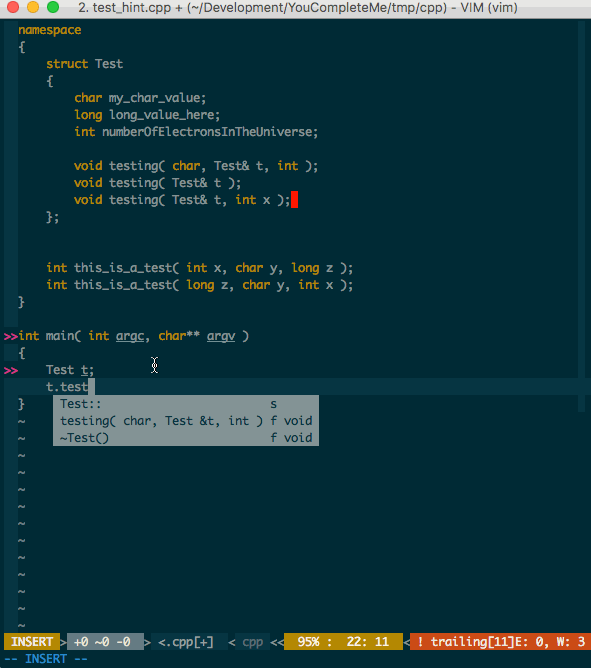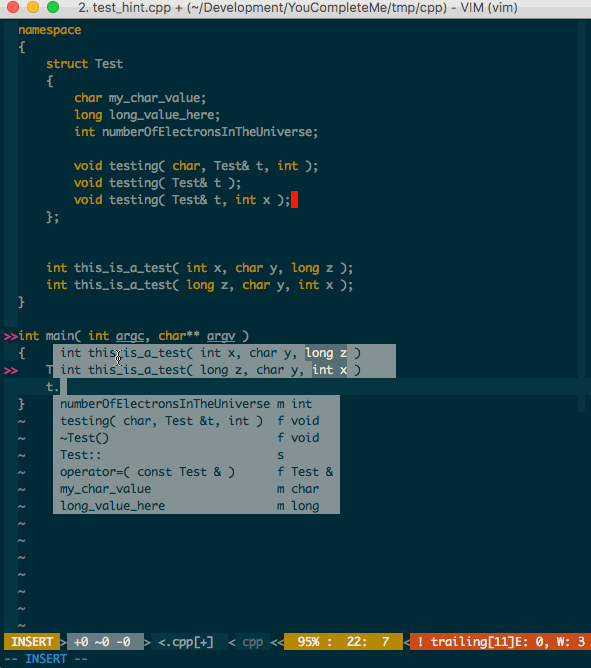This RFC proposes introducing a second popup menu in insert mode to display
method argument hints, current parameter, etc. similar to a number of IDEs and
editors. The proposal is to allow scripts to control this (such as on insert of
( and ) characters) and for it to be non-interractive and not to interfere
with insert-mode completion.
The purpose of the RFC is to guage the appetite from Bram and the community for such a feature, and to discuss the design/functional behaviours prior to committing to an implementation/etc.
There are a number of Vim plugins which attempt to provide some IDE-like features using Vim's completion system, in combination with omnifuncs and insert-mode completion that is built-in. Examples:
- YouCompleteMe - https://github.com/Valloric/YouCompleteMe
- neocomplete, deoplete, neocomplcache, and other friends
- eclim?
- any number of hundreds of omnifuncs
- Microsoft language server client?
- Various other "async complete" plugins
- possibly any number of other completion plugins, including implementations specific to particular languages (e.g. using omnifunc), or using l
In their simplest form, these provide a list of identifiers which are semantically valid to be inserted at the current cursor position (or the result of the equivalent of omnifunc's 'findstart' request), using the insert-mode completion APIs provided by Vim.
One of the most commonly requested features for YouCompleteMe is the ability to display the valid arguments for function calls, as well as semantically correct identifiers. This feature is known as "argument hints", "parameter completions", "signature help" or suchlike. Microsoft's Language Server Protocol refers to them as "Signature Help".
For example, the user types something like the following, with the cursor on
^:
typedef struct pum_T
{
int pum_item_count;
int pum_selected;
pumitem_T* items[];
} pum;
void pum_display_item( pum_T* pum,
char_u* message,
pumitem_T* item_list );
void pum_display_item( pum_T* pum,
int selected_item,
pumitem_T* item );
void main(void)
{
pum_T pum = init_pum();
pum_display_item( pum, pum.^
}Current completion systems (or omni-completion, invoked with <C-x><C-o>) would
typically present a popup menu with the valid options from the definition,
such as:
int pum_selectedint pum_item_count
Methods often have many more arguments than this toy example, and
the declaration is not likely visible when it is used. Instead, many IDEs and
other editors provide a second "popup" when the user types the (. Typically,
this is above rather than below the current line and contains the list of
overloads of the fucntion and their arguments, often highlighting (one way or
another) the "current" argument being entered.
For example, it might look like this:
|------------------------------------------------------------------------|
| pum_display_item( pum_T* pum, **char_u *message**, pumitem_T* item ) |
| pum_display_item( pum_T* pum, **int selected_item**, pumitem_T* item ) |
|------------------------------------------------------------------------|
pum_display_item( pum, pum.^
|---------------------------|
| pum_selected int |
| int pum_item_count int |
|---------------------------|
-
The preview window. By using the extra data in the completion menu item structure, we can show some static information in the preview window. The drawbacks are that the preview window has to always be visible (taking up valuable screen real estate), or it pops in and out of visibility, causing the current row to shift disconcertingly on the screen. Requires
previewin thecompleteoptand other autocmds etc. to show/hide it. Cursor moving into and out of the preview window triggersBufEnterautocoms, which causes meaningful lag when the completion menu is visible (OK, this could be blamed mostly on the plugins usingBufEnterautocommand, but you get the picture). -
Oblitum/YouCompleteMe. This is an approach using the standard PUM 100% with no hacks. The drawback is that only the current argument is displayed, and mutually exclusively with suggestions for the current identifier.
-
a YouCompleteMe test which also uses the command line (user experience is not good using the command line, as the text can be clobbered by other things, timers, etc.)
-
jedi-vim. A python omnifunc plugin uses conceal highlighting to simulate a second menu. The conceal apprach seems to involve actually changing the buffer contents and relying on special highlight groups to make the appearance of a second "menu". Ingenious, perhaps, but probably not fun to implement or maintain. With no disrespect to the author, it seems like a hack.
There are probably others; I just listed the ones I researched.
Vim currently supports a single popup menu, which is used for:
- insert-mode completion
- balloons (a more recent addition, only in the terminal)
In the GUI, balloons are implemented as a popover window via a GUI-specific mechanism.
The proposal is to allow 2 (mostly) independent popup menus to be displayed insert mode:
- the interractive completion menu, controlled without changes (via CTRL-X mode)
- a second menu not overlapping the completion menu controlled only by scripts.
For the purposes of this RFC (and brevity), I will refer to the menus as:
- the completion menu, and
- the hint menu
respectively.
Priority in terms of display is always given to the completion menu, as that is the one the user interracts with. The completion menu prefers to draw below the cursor (if there is room), above otherwise.
The hint menu prefers (for example):
- if there is no completion menu:
- if there is room above, above the cursor line
- otherwise if there is blow, below the cursor
- otherwise not at all
- if there is a completion menu, and it wants to be below the cursor:
- if there is room above, above the cursor line
- otherwise, not at all
- if there is a completion menu, and it wants to be above the cursor:
- if there is room below, below the cursor line
- otherwise, not at all
Both the completion menu and the hint menu are cleared when a balloon is displayed.
Discussion point: This is open for debate and I would love to hear thoughts on it. I see there are a couple of options here:
-
"Pass-through". The contents of the hint menu are at the discretion of the script. Borrowing from the approach taken for balloons, the menu supports a list of strings, but does not perform any additional formatting (such as spacing/splitting).
-
"Call a spoon a spoon". The purpose of the feature is argument hints, so we make the API specific to that. Anything else is YAGNI. e.g. The API is passed a list of signatures, including the active signature and argument. Vim then handles the display and highlighting, allowing the script interface to be relatively simple, while restricting (perhaps) the amount of innovation.
One could argue that parameter hints are a special case of balloons. The special case is that they are visible at the same time as completions in insert mode. However, I'm not totally convinced that's the right approach. In particular, balloons are very different in the terminal and GUI, and I feel like this feels more similar to insert-mode completion than any existing expected use case for balloons.
So instead, the proposal is to actualy just add (yet) another popupmenu, whose data is independent of the existing popopmenu and balloon data.
The general idea would be to re-use most (if not all) of the existing popupmenu code, by factoring its data out and passing an instance of "a" pum to most functions. A vimscript API controls the hint pum, and the API for completion is unchanged.
Here's a (very) brief idea of how I think it could be done:
-
Phase 1, refactor so that pum data isn't quite-so global
- store all pum-related state in a struct pum_T
- declare a single instance of this called
compl_pum - use
compl_pumfor completion and balloons exactly as it is used today - No functional change.
-
Phase 2, add the second pum
- create a vimscript API that allows a script to display the hint pum in insert mode
- provide experrimental support for:
- hint_pum_set( {arg} ) = set the contents of the hint menu
- arg contents TBD, but a list of strings, maybe or something else...
- hint_pum_show( column ) = enable display of the hint menu
- hint_pum_hide() = disable display of the hint menu
- hint_pum_visible() = return whether hint menu is displayed
- hint_pum_set( {arg} ) = set the contents of the hint menu
- hint the hint pum when exiting insert mode (and probably a load of other things i haven't thought of)
-
Phase 3, allow hint menu to highlight the current argument
- Details sketchy, as they depend on some of the previous discussion points.
- One option is to embed something, perhaps using magic string markers in the menu input strings, to "bold" some section.
- Another option might be to somehow use new specific highlighting groups, or something along those lines, combined with knowledge about which argument is selected.
I'd welcome comments on anything including:
- The welcomeness/appetite for such functionality
- The generality of the proposal (or otherwise)
- The overall approach, related ideas/works/etc.
- Niggly bikeshedding; the more the merrirer
Of course nothing is set in stone at this stage, but I did write a proof of concept about 12 months ago as part of the research into the idea.
Some demos are attached to the gist as comments. I can point to the code in Vim and YouCompleteMe, but it is very hacky and exploratorys, so it would be completely re-engineered before any PR/patch is sent.


Demo: